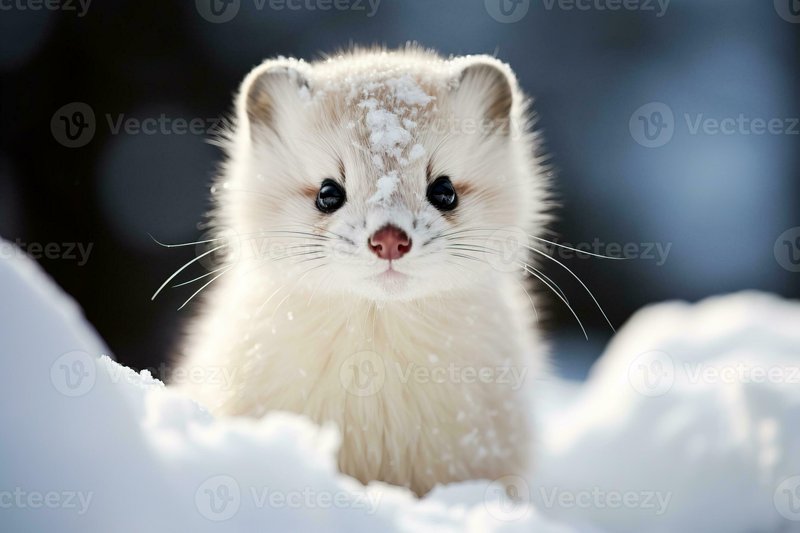
Imagine a tiny daredevil, darting through the underbrush, always alert and ready to adapt. That’s the weasel for you. With their slender bodies, sharp minds, and keen instincts, these animals have honed a set of survival skills that allow them to face extreme weather, scarce food supplies, and even predators much larger than themselves. Let’s dive into the world of weasels and discover the secrets behind their survival in harsh environments.
Adapting to Extreme Cold
Weasels are particularly well-known for their ability to withstand frigid temperatures, especially species like the *ermine*, also known as the stoat. When winter rolls in, these little animals change their coats from brown to white. This not only helps them blend in with the snowy surroundings, but it also keeps them warm. It’s almost like having a built-in winter jacket!
This ability to change color is an example of what scientists call *adaptation*. Weasels have evolved to not only survive but thrive in areas where temperatures can plunge. They have a thick layer of fur, which acts as insulation. It’s fascinating how Mother Nature equips these little guys with what they need to stay comfortable, even when the weather outside is frightful.
You might be wondering how they hunt for food in such harsh conditions. Well, weasels are agile and crafty. They rely on their speed and stealth to sneak up on birds, rodents, and other small animals, even under layers of snow. Their keen sense of hearing helps them locate prey that may be hiding beneath the snow. When it comes to finding food, weasels are a true testament that size doesn’t matter; it’s all about strategy!
Hunting Techniques
Speaking of hunting, weasels are quite skilled at tracking down their meals. One of their most impressive techniques is their ability to hunt in pairs or small groups. This teamwork enables them to corner prey, making it easier to catch something to eat. Imagine a tiny wolf pack working together to catch their dinner—it’s pretty amazing!
Weasels often exploit their environment creatively. They can enter small burrows or tunnels that other predators can’t. This gives them access to areas rich in food sources—places where other animals are too big to follow. Their slender bodies allow them to squeeze through tight spots, making them expert hunters in their domain.
If you’ve ever seen a weasel in action, you know they move rapidly. Their quick darting and turning make them hard to catch. This speed serves as a major advantage, especially when faced with larger predators like hawks or foxes. They can change direction in the blink of an eye, which is key in evading danger.
Resourcefulness in Finding Shelter
Finding shelter is crucial for any animal trying to survive in tough conditions, and weasels are no exception. During the winter months, they often take refuge in abandoned burrows made by other animals, such as rabbits or mice. This not only keeps them warm but also provides a steady source of food, as the burrow might still have some leftover snacks!
In more forested areas, weasels will also use the natural landscape to their advantage. They can nestle into piles of leaves, under tree roots, or even within logs to avoid harsh weather. It’s like they have a bag of tricks to find the coziest hideouts, no matter what the environment throws at them.
You might be surprised to learn that these little critters are quite clean and organized! They often create separate areas for sleeping and eating within their shelter. This helps them avoid contamination and reduces the risk of getting sick—an important factor when every meal counts in survival.
The Importance of Speed and Agility
Weasels are known for their incredible speed and agility, which are essential for navigating their rugged habitats. Their long, flexible bodies allow them to twist and turn quickly as they chase prey or escape predators. Imagine a little gymnast who can flip and roll while on the move—that’s pretty much a weasel in action!
This agility is also beneficial when hunting in dense underbrush or rocky terrains. Weasels can sneak through tight spots, which larger animals can’t access. Their remarkable reflexes help them dodge attacks from other predators, making it much easier to stay alive.
Interestingly, weasels are also known to engage in playful behavior. You might catch them rolling around with each other or darting in and out of their burrows. This isn’t just for fun; it sharpens their reflexes and improves their agility, making them even better at survival tactics. It’s nature’s way of ensuring that they stay sharp and ready for anything!
Staying Hydrated
You know how important water is for any creature, right? Weasels are no exception. In harsh environments, finding fresh water can be a challenge. Luckily, these little animals are resourceful. They often get the moisture they need from the food they consume. Small rodents and birds contain a fair amount of water, so weasels cleverly use that to their advantage.
Additionally, weasels have learned where to find hidden water sources in their habitats. During the warmer months, they often utilize streams or ponds. They’re typically cautious drinkers, always on alert for any signs of danger while sipping on water. This careful approach keeps them hydrated while minimizing risk.
Sometimes, weasels can also be seen eating snow during the winter months. While it might not be the most straightforward way to hydrate, every drop counts when survival is on the line! These adaptable strategies ensure they can keep going, even when times are tough.
Social Structure and Behavior
While weasels are often seen as solitary animals, they can also exhibit some interesting social behaviors, especially during the breeding season. During this time, males will compete for females, which can lead to temporary alliances among males. This social structure might seem volatile, but it’s part of their natural instinct to ensure the strongest genes are passed on.
Once the mating season is over, weasels tend to go back to their independent ways. Here’s the thing—being solitary can be an advantage. It reduces competition for food and allows them to hunt without interference. In harsh environments, this independence can make a significant difference. They can establish territories where they feel most comfortable and secure.
Interestingly, weasels also communicate with each other using a variety of sounds, such as chirps and whistles. This communication can alert others to nearby dangers or even signal a potential mate. When you think about it, their social interactions are quite sophisticated for such small creatures!
Weasels are incredible survivors, managing to thrive in some of the harshest environments on Earth. From their winter adaptations and clever hunting techniques to their resourceful shelter-seeking behavior, these little animals have honed the skills they need to face life’s challenges head-on.
Their agility, social structure, and unique resourcefulness make them truly remarkable creatures in the animal kingdom. As you learn more about weasels, it’s hard not to appreciate the clever ways they’ve adapted to thrive, no matter what nature throws at them. Next time you think about survival in the wild, remember the weasel—a tiny hero that proves that even the smallest creatures can be mighty.

